APAC Security Testing Market Size
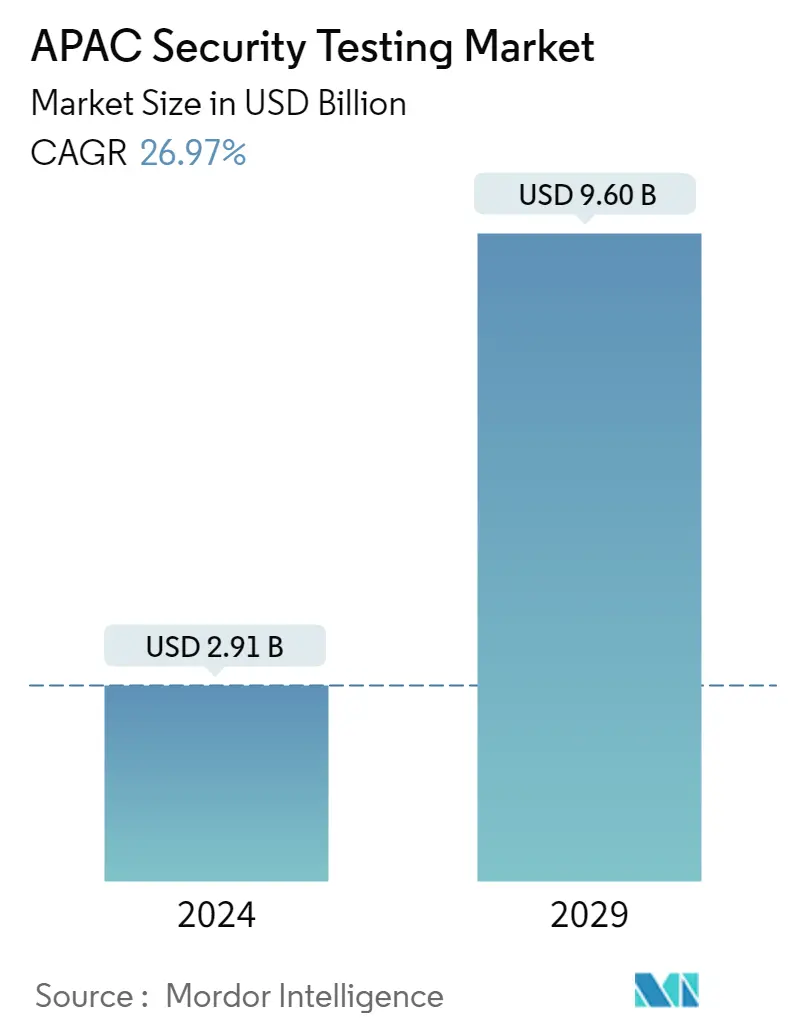
| Study Period | 2019 - 2029 |
| Base Year For Estimation | 2023 |
| Market Size (2024) | USD 2.91 Billion |
| Market Size (2029) | USD 9.60 Billion |
| CAGR (2024 - 2029) | 26.97 % |
| Market Concentration | Low |
Major Players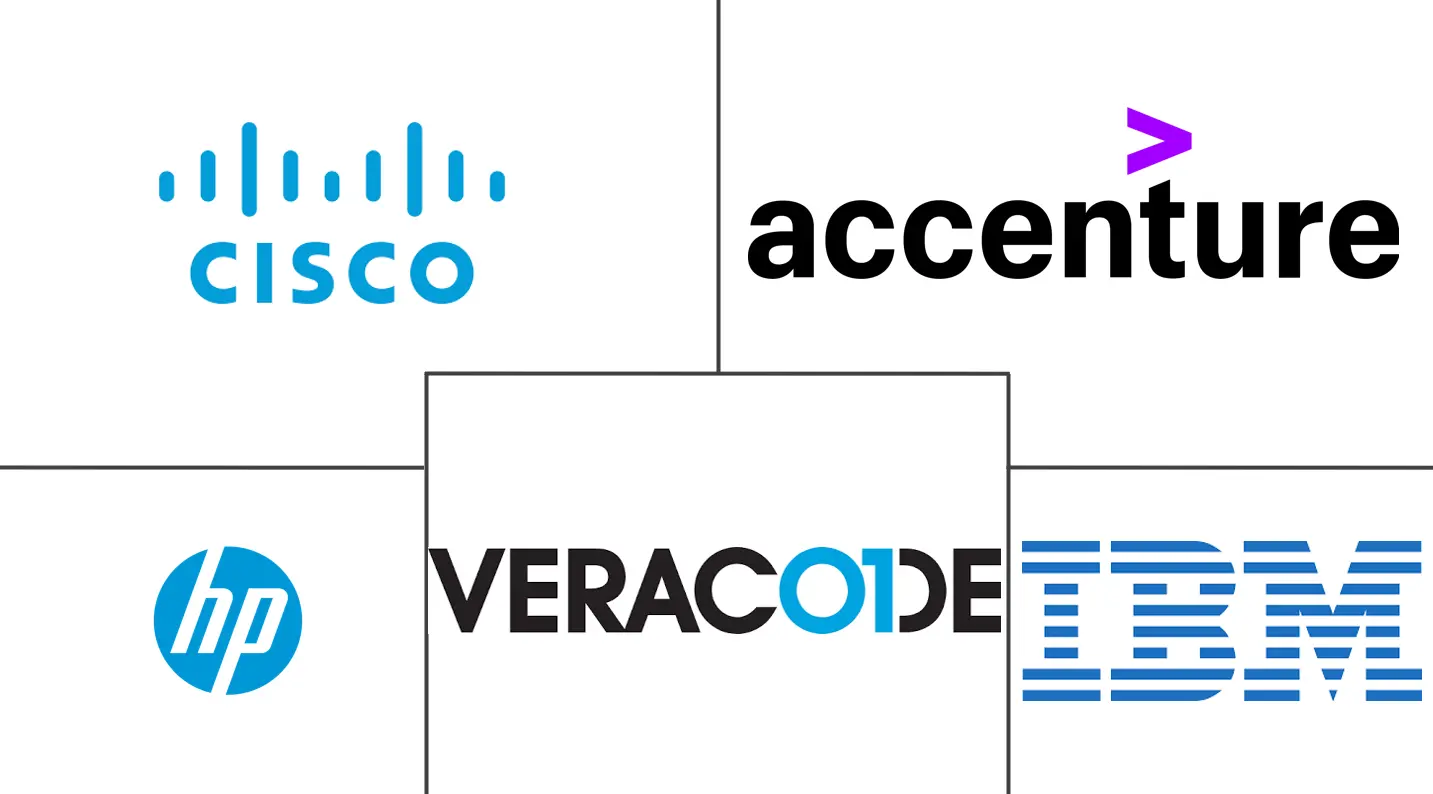
*Disclaimer: Major Players sorted in no particular order |
APAC Security Testing Market Analysis
The APAC Security Testing Market size is estimated at USD 2.91 billion in 2024, and is expected to reach USD 9.60 billion by 2029, growing at a CAGR of 26.97% during the forecast period (2024-2029).
The demand for security testing in APAC region is expected to increase with the escalation in the number of attacks that countries in the region are battling every day.
- Both private companies and governments are battling cyber-attacks on their networks every day. Singapore was under siege from cyber-criminals last year, and for 229 days, cyber-criminals plundered and phished data out from government sites. Countries like India, the Philippines, and South Korea face constant cyber-attacks.
- As enterprises consider providing comprehensive visibility and advanced layer security, including intrusion prevention, web filtering, threat protection, and application control, they face a major challenge managing these point products without integration and lack of visibility.
- In June 2023, McAfee Corp., one of the global leaders in online protection, announced McAfee Business Protection, a new comprehensive security solution for small business owners that collaborated with Dell Technologies. McAfee Business Protection assists Dell small business customers prevent cyber threats and vulnerabilities with security, identity and dark web data monitoring, VPN, web protection for safe browsing, and more.
- Security Testing will ensure that the systems and applications on a network are secure. The evolution of Dynamic application security testing beyond the security testing of back-end web applications has opened up new avenues for the security testing market. They now have the capabilities to test next-generation applications. The ability of some of the testing providers to enable interaction between their static and dynamic security testing techniques provides more detailed information, which is quite useful in QA testing to provide more meaningful results to developers.
- It has been estimated that over 99% of attacks are known as Common Vulnerabilities and Exposures (CVEs). A traditional defense probes the system using manual or automatic vulnerability scanning techniques. However, this produces a lot of redundant and irrelevant information that sheds no light on whether a hacker can use the vulnerability to reach a critical asset. The only solution today is human penetration testing, but infrequent Testingperiodic does not reflect the network's dynamic nature, especially in today's virtual and cloud-based environments.
- These solutions protect web-based and mobile-based applications from vulnerabilities and threats by installing encryption applications and various security testing procedures during the application development life cycle. Business applications hold critical organizational data and are the target of cybercriminals.
- The emergence of HTML5, which requires higher maturity and adoption, drives innovation in DAST. The emergence of cloud computing, along with the ability to offer Testing as a Service (TaaS) with the flexibility to test sensitive applications on-premises and outsource others, has enabled firms across various sectors like BFSI, Government, and Public Sector, Healthcare, and Retail to include Testing in their operations.
APAC Security Testing Market Trends
Transition to Online Payment Methods is Expected to Drive the Market Growth
- Asia Pacific, investments in security oriented products such as security testing, endpoint security, VPN, and firewalls bumped up due to the increased spending by both governments and enterprises (particularly in the banking, telecom, and professional services industry. Australia and India are the next two largest countries in terms of security spending due to the presence of many businesses catering to domestic and international customers.
- As payment methods grow more digital, there is increased pressure for enhanced security and online fraud protection. According to Worldpay, digital or mobile wallets are expected to account for 72 percent of all online shopping payments in Asia Pacific area by 2025. This was an increase from 2021 when 69 percent of e-commerce payments in Asia Pacific area were made using digital wallets.
- In the previous five years, digital wallets in Asia Pacific (excluding China) have nearly quadrupled their proportion of e-commerce transaction value, and their numbers are expected to expand gradually over the next three years. Similarly, in the previous five years, digital wallets' percentage of payment transaction value at POS has increased sixfold. The rise of digital wallets is expected to accelerate in the future.
- Cash use in Asia Pacific is expected to reduce by half between 2021 and 2026, from 16% to 8% of POS transaction value, owing to the expansion of mobile payments and the adoption of QR codes. Cash is expected to decrease below 10% of POS transaction value in several mature consumer economies, including the nations of Hong Kong, South Korea, New Zealand, China, and Australia, by 2026.
- Despite the fewer users, its large population ensures sufficient cash flow. China has been a leader in mobile payments in APAC even before the pandemic, maintaining a steady flow of users. The country's most prominent payment channels include Alipay and WeChat Pay, boosted even further by the pandemic. The increase in users is also reflected by malicious actors looking for loopholes in the infrastructure. Concerns over any possible cracks have encouraged governments to control financial malware.
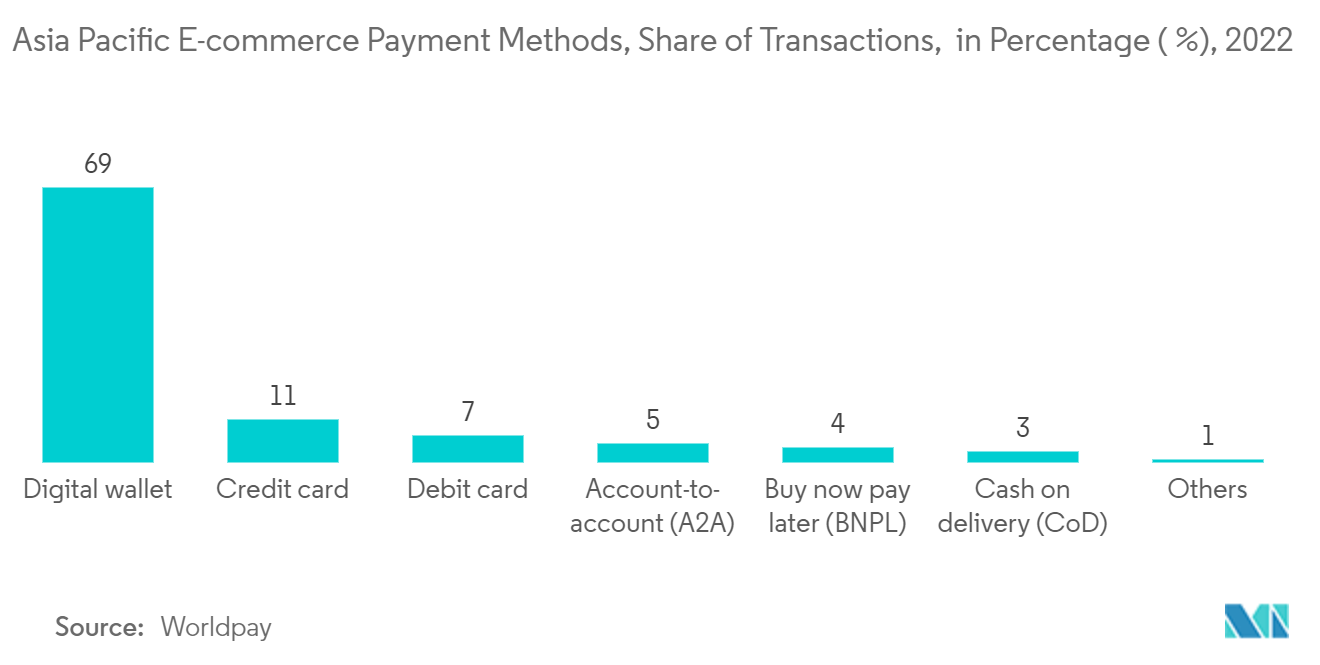
India is Expected to Hold Significant Market Share
- India is adopting advanced technologies, increased cyber incidents, and the growing number of interconnected machines in the country are some of the main factors that would benefit the market for security tests in India. Government initiatives and digitalization in the country will create several prospects for growth. The shift of businesses to digitalization has been enormous in recent years.
- India also witnessed the highest number of domain name system or DNS attacks in recent years, with 12.13 attacks per organization, even though the cost of attacks in the country decreased by 6.08% to INR 5.97 crores (USD 0.72 Million), according to International Data Corporation's DNS Threat Report.
- Further, India's technology atmosphere is rapidly growing; locally based businesses are expanding globally, while multinational conglomerates are rapidly investing in Indian markets. Such initiatives by the organizations and the increasing number of cyber-attacks are expected to drive the demand for security testing in the region.
- In April 2023, McAfee Corp announced the extension of its nine-year partnership with Samsung to protect customers' data and information from online threats; through this partnership, Samsung smartphones, including the new Galaxy S23 Ultra, Galaxy S23+, and Galaxy S23, as well as the Galaxy Book3 series, now come pre-installed with antivirus protection powered by McAfee. In addition to smartphones, the partnership gives rise to improved safety for Samsung tablets and computers.
- According to the IBM Security X-Force Threat Intelligence Index 2023, Asia-Pacific remained the most-attacked region in 2022, representing 31% of all incidents. This figure reflected a five percentage point increase from the overall number of attacks in the region to which X-Force reacted in 2021.
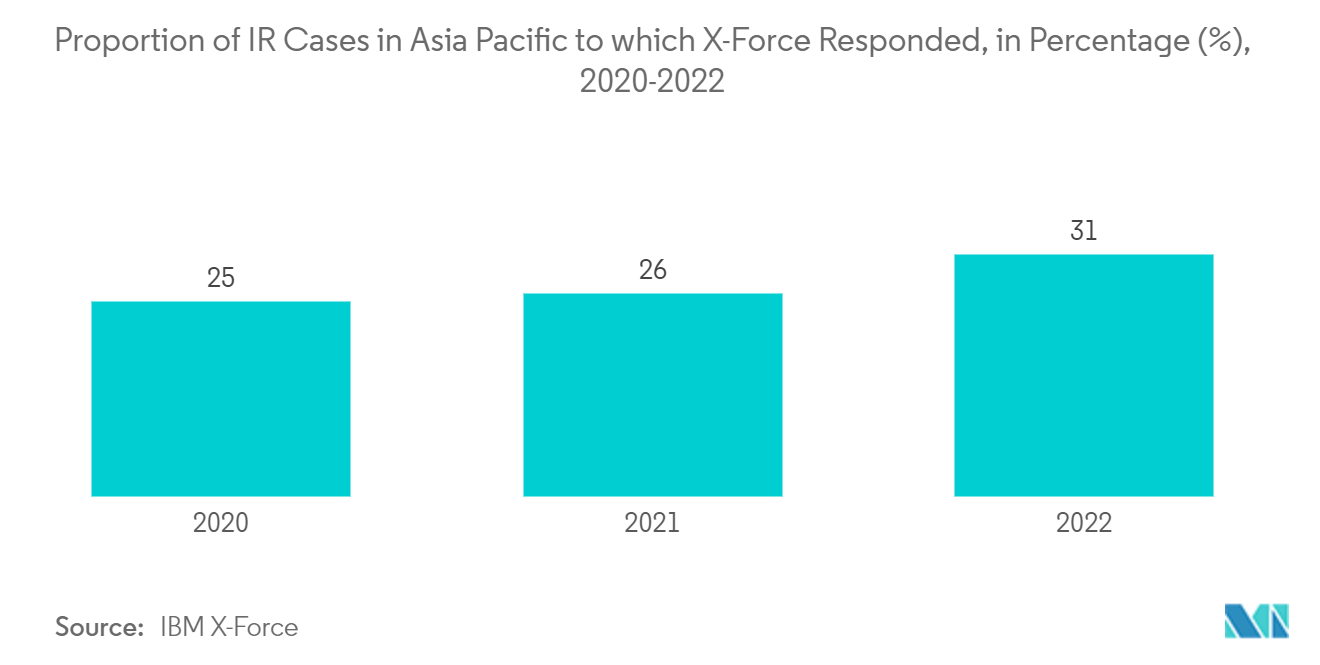
APAC Security Testing Industry Overview
The Asia Pacific security testing market is fragmented, with major players operating across the region. These players continuously adopt various strategies, such as mergers & acquisitions, product developments, partnerships, and collaborations, to increase their market presence and acquire more customers.
In February 2023, UNICC announced a strategic partnership with Veracode, one of the Gartner Magic Quadrant leaders in AppSec services. Veracode offers a consolidated platform for AppSec testing, including its Static Analysis, Software Composition Analysis and Dynamic Analysis solutions, and advisory support and best practices for AppSec deliverables and eLearning in secure coding for developers.
In August 2022, the renowned technology services and consulting firm Wipro Limited stated that it earned the distinctions of Modern Compute Security and Managed Application Security Testing Specialization in the Amazon Web Services (AWS) Level 1 Managed Security Service Provider (MSSP) Competency. The AWS Level 1 MSSP Competency made it quicker and simpler for clients to choose the best MSSP to assist them in achieving their goals for business risk and cloud strategy confidence. The clients benefited from Wipro's achievement of further specialist distinctions and its role as a launch partner for AWS Level 1 MSSP Competency.
In September 2022, Checkmarx, the global pioneer in developer-centric application security testing (AST) solutions, launched the Checkmarx One platform in Singapore for the ASEAN area to assist regional developers in quickly testing, rectifying, and protecting their application code. To serve on-premises, cloud, and hybrid development environments, Checkmarx One is built for cloud-native application security. It also delivered from the cloud. From the initial code commit made by a developer until the software was sent into production, it discovered security vulnerabilities and improved remediation across the software development life cycle.
APAC Security Testing Market Leaders
-
HP Inc
-
IBM
-
Cisco Systems Inc.
-
Veracode
-
Accenture PLC
*Disclaimer: Major Players sorted in no particular order
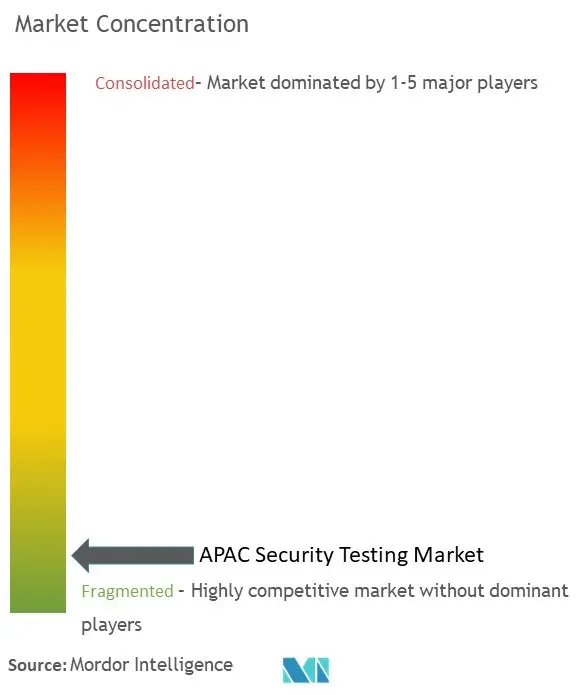
APAC Security Testing Market News
- April 2023: Harness, the Modern Software Delivery Platform company, revealed the most recent update of its Security Testing Orchestration (STO) module, allowing creators to identify safety concerns earlier in the process of developing software while offering a novel approach to ensure software application vulnerabilities are deduped, identified, remediated, and prioritized. With the help of these new tools, developers can collaborate more effectively with security practitioners and save their company time, energy, and resources while lowering risk.
- February 2023: India joined its Quad allies, Australia, Japan, and the United States, in starting a campaign to increase awareness of the hazards on the Internet in the Indo-Pacific region and beyond due to the growing attacks on its vital cyber infrastructure by hackers associated with China. India, Australia, Japan, and the US will soon see the start of a public push by The Quad to increase cyber security. Internet users from Indo-Pacific and beyond will also be expected to participate in the Quad Cyber Challenge. The vow to adopt safe and responsible online behaviors is expected of the participants.
- May 2022: An initiative to advance Malaysia's national digitalization goal was presented by the government of Malaysia, one of Southeast Asia's most dynamic economies, and Cisco, a global supplier of Internet-enabling technology. The ceremony further demonstrated Cisco's commitments, established the groundwork for its new CDA program in Malaysia, and was closely aligned with MyDIGITAL, the Malaysia Digital Economy Blueprint that aimed to promote social inclusion and economic resilience through widespread digital transformation.
APAC Security Testing Market Report - Table of Contents
1. INTRODUCTION
- 1.1 Study Assumptions and Market Definition
- 1.2 Scope of the Study
2. RESEARCH METHODOLOGY
3. EXECUTIVE SUMMARY
4. MARKET INSIGHTS
- 4.1 Market Overview
-
4.2 Industry Attractiveness - Porter's Five Forces Analysis
- 4.2.1 Bargaining Power of Buyers
- 4.2.2 Bargaining Power of Suppliers
- 4.2.3 Threat of New Entrants
- 4.2.4 Threat of Substitute Products
- 4.2.5 Intensity of Competitive Rivalry
- 4.3 Value Chain / Supply Chain Analysis
- 4.4 Assessment of the Impact of COVID-19 on the Market
5. MARKET DYNAMICS
-
5.1 Market Drivers
- 5.1.1 Proliferation of Existing Malware that is Continually Attacking Devices
- 5.1.2 Increasing Number of Connected Devices
- 5.1.3 Transition to online payment methods
-
5.2 Market Restraints
- 5.2.1 Hesitation to adopt the digitization techniques
- 5.3 Technology Snapshot
6. Market Segmentation
-
6.1 Deployment Model
- 6.1.1 On-premise
- 6.1.2 Cloud
-
6.2 Type of Service
- 6.2.1 Application Security Testing
- 6.2.1.1 Introduction
- 6.2.1.1.1 Mobile Application Security Testing
- 6.2.1.1.2 Web Application Security Testing
- 6.2.1.1.3 Cloud Application Security Testing
- 6.2.1.1.4 Enterprise Application Security Testing
- 6.2.1.2 Testing Method
- 6.2.1.2.1 SAST
- 6.2.1.2.2 DAST
- 6.2.1.2.3 IAST
- 6.2.1.2.4 RASP
- 6.2.2 Network Security Testing
- 6.2.2.1 Introduction
- 6.2.2.1.1 Firewall Testing
- 6.2.2.1.2 Intrusion Detection/Intrusion Prevention Testing
- 6.2.2.1.3 VPN Testing
- 6.2.2.1.4 URL Filtering
-
6.3 Testing Tools
- 6.3.1 Penetration Testing Tools
- 6.3.2 Software Testing Tools
- 6.3.3 Web Testing Tools
- 6.3.4 Code Review Tools
- 6.3.5 Other Testing Tools
-
6.4 End-User Industry
- 6.4.1 Government
- 6.4.2 Healthcare
- 6.4.3 BFSI
- 6.4.4 Manufacturing
- 6.4.5 Retail
- 6.4.6 IT and Telecommunications
- 6.4.7 Other End-User Industries
-
6.5 Country
- 6.5.1 China
- 6.5.2 India
- 6.5.3 Japan
- 6.5.4 Rest of Asia Pacific
7. Vendor Market Share
8. COMPETITIVE LANDSCAPE
-
8.1 Company Profiles
- 8.1.1 HP
- 8.1.2 IBM
- 8.1.3 Veracode
- 8.1.4 McAfee
- 8.1.5 Cisco Systems Inc
- 8.1.6 Core Security Technologies
- 8.1.7 Cigital Inc
- 8.1.8 Offensive Security
- 8.1.9 Applause App Quality Inc.
- 8.1.10 Accenture PLC
- 8.1.11 ControlCase LLC
- 8.1.12 Paladion Networks
- 8.1.13 Maveric Systems
- 8.1.14 Netcraft
- 8.1.15 Synerzip
- *List Not Exhaustive
9. INVESTMENT ANALYSIS
10. MARKET OPPORTUNITIES AND FUTURE TRENDS
** Subject To AvailablityAPAC Security Testing Industry Segmentation
Security testing is a form of software testing that aims to find system vulnerabilities and ensure that the system's information and resources are safe from attackers. Security testing aims to find all the system's potential shortcomings that enable workers or outsiders to steal data, money, or goodwill from the company.
The Asia-Pacific security testing market is segmented by service (application security testing, network security testing), tools (penetration testing tools, software testing tools, web testing tools, code review tools), By End-User industry (government, healthcare, financial services, manufacturing, retail, IT and telecommunication, and others), by technology overview (technology snapshot, deployment models, ongoing developments, types of security testing, security testing tools), by deployment model (on-premise, cloud) and country (China, India, Japan).The market sizes and forecasts regarding value (USD) for all the above segments are provided.
| Deployment Model | On-premise | ||
| Cloud | |||
| Type of Service | Application Security Testing | Introduction | Mobile Application Security Testing |
| Web Application Security Testing | |||
| Cloud Application Security Testing | |||
| Enterprise Application Security Testing | |||
| Type of Service | Application Security Testing | Testing Method | SAST |
| DAST | |||
| IAST | |||
| RASP | |||
| Type of Service | Network Security Testing | Introduction | Firewall Testing |
| Intrusion Detection/Intrusion Prevention Testing | |||
| VPN Testing | |||
| URL Filtering | |||
| Testing Tools | Penetration Testing Tools | ||
| Software Testing Tools | |||
| Web Testing Tools | |||
| Code Review Tools | |||
| Other Testing Tools | |||
| End-User Industry | Government | ||
| Healthcare | |||
| BFSI | |||
| Manufacturing | |||
| Retail | |||
| IT and Telecommunications | |||
| Other End-User Industries | |||
| Country | China | ||
| India | |||
| Japan | |||
| Rest of Asia Pacific |
APAC Security Testing Market Research FAQs
How big is the APAC Security Testing Market?
The APAC Security Testing Market size is expected to reach USD 2.91 billion in 2024 and grow at a CAGR of 26.97% to reach USD 9.60 billion by 2029.
What is the current APAC Security Testing Market size?
In 2024, the APAC Security Testing Market size is expected to reach USD 2.91 billion.
Who are the key players in APAC Security Testing Market?
HP Inc, IBM, Cisco Systems Inc., Veracode and Accenture PLC are the major companies operating in the APAC Security Testing Market.
What years does this APAC Security Testing Market cover, and what was the market size in 2023?
In 2023, the APAC Security Testing Market size was estimated at USD 2.29 billion. The report covers the APAC Security Testing Market historical market size for years: 2019, 2020, 2021, 2022 and 2023. The report also forecasts the APAC Security Testing Market size for years: 2024, 2025, 2026, 2027, 2028 and 2029.
APAC Security Testing Industry Report
Statistics for the 2024 APAC Security Testing market share, size and revenue growth rate, created by Mordor Intelligence™ Industry Reports. APAC Security Testing analysis includes a market forecast outlook to for 2024 to 2029 and historical overview. Get a sample of this industry analysis as a free report PDF download.



